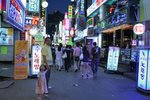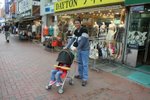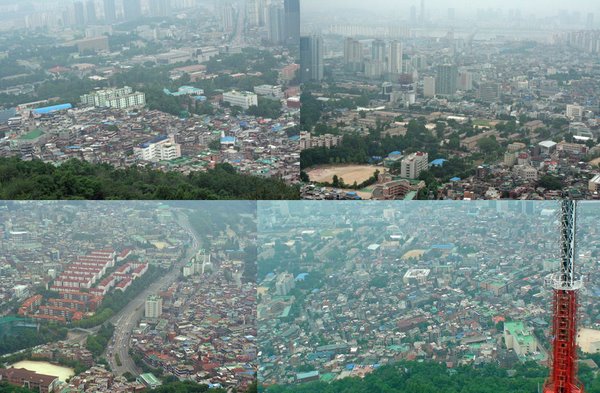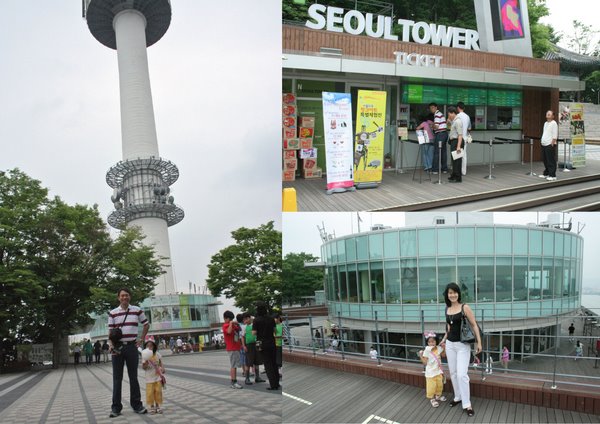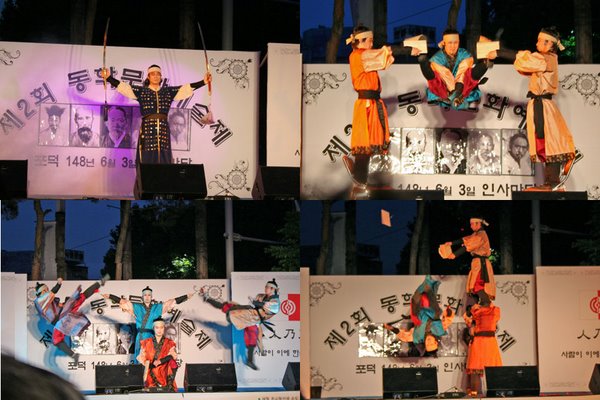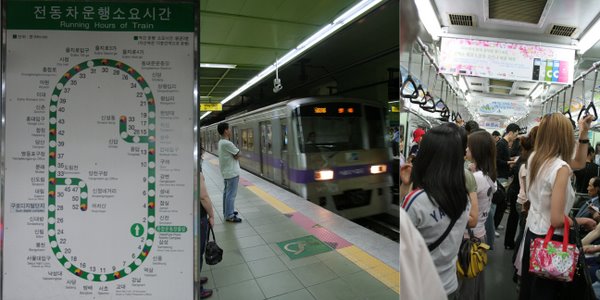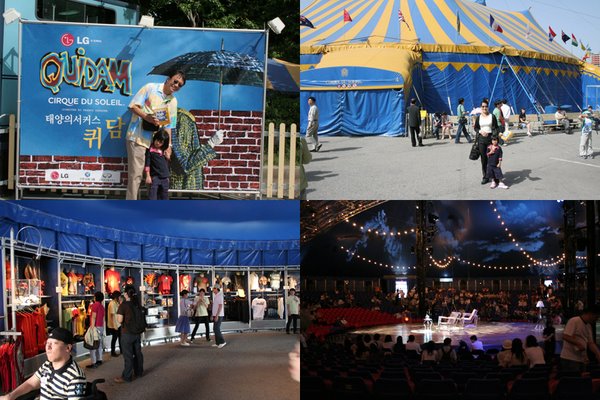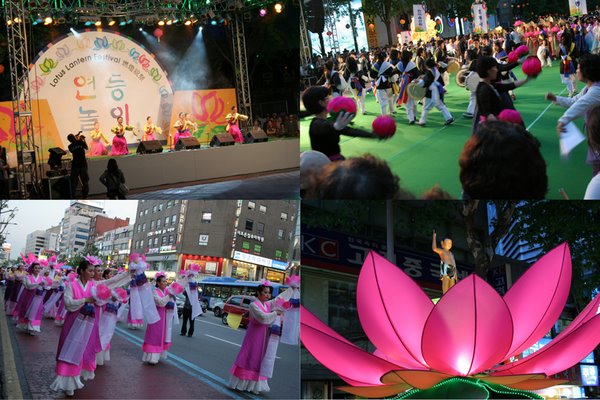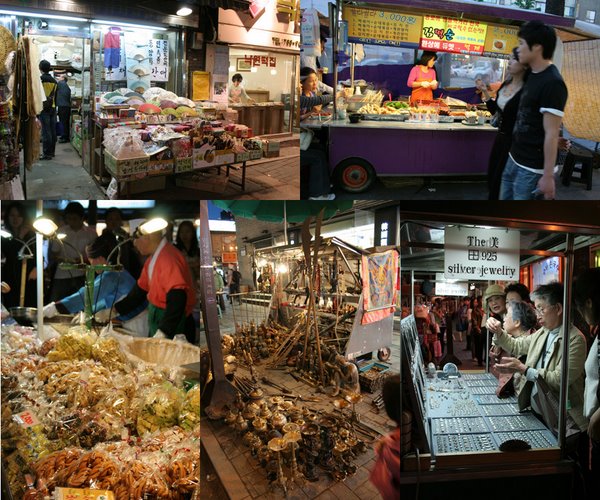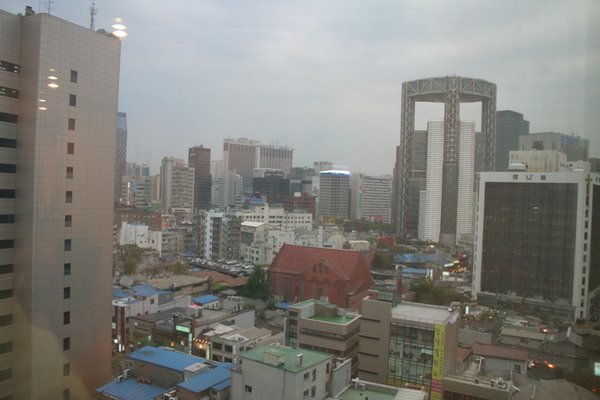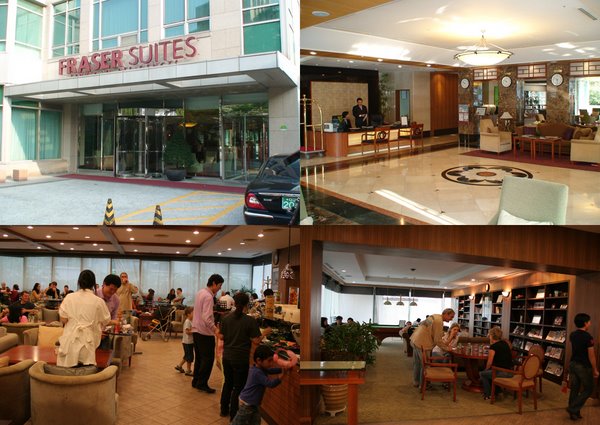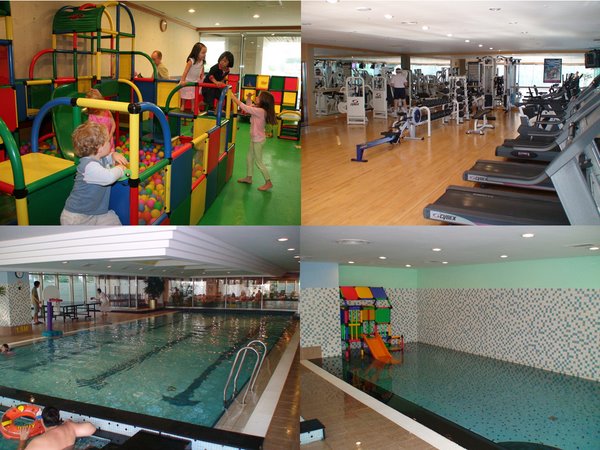25 June 2007
After more than a month in Seoul , I finally needed a haircut. Unfortunately, this was easier said than done.
One thing you will notice as you travel around the city is there is a barber pole sign at almost every street corner. However, this does not necessarily represent a barber shop. It could also mean a massage parlor, a Turkish bath, or an establishment which strictly services male clientele. In fact, much earlier, while I was looking for a place to have my hair cut, I happened to enter one of these facilities. It was located at the basement (one of the signs it more likely is not a barber shop) of one of these regular looking buildings But upon going down the stairs and opening the door, I noticed only cots and not a single barber chair whatsoever. A woman, who was lying on one of the cots, immediately approached me. But before she even said a word, I immediately retreated out of the door.
A local Korean told me that the government years ago warned these establishments to ensure that they had a barber on the staff. Hence, a majority can perform barber services, albeit not that good, but there will always be the offer of "extra" service. You see, prostitution is illegal in Korea. However, because of the large American military facility in the country and of the masculine tendencies inherent in the local culture, this profession is a very much alive and flourishing. In fact, there is a fear that whenever the Korean police authorities decide to crack down on the "red light districts", the women simply go underground by transferring to the "barber shops".
Fortunately, my colleagues in the office suggested that I try the BLUE CLUB. It so happened there was a branch across our office, and so they directed me towards it. This had the usual barber pole but instead of the red, white, and blue colors, it was only white and blue. Upon entering, I was relieved to see a number of barber's chairs and a couple of guys actually having their hair cut. Although my barber could not talk in English, she was able to show me pictures of different styles of haircuts. Upon finishing, she did not tidy me up, so initially, I wasn't that satisfied when I checked myself in the mirror. But upon arriving at the apartment, my wife commented that she liked my trim. I looked at the mirror in our bathroom and she was right! I paid KW 6000 for a regular haircut which also allows you to wash your hair after the haircut is done. This was a first for me because that kind of self service is not offered in Manila. When I informed two locals that I had used this particular barber, they immediatly commented that this was cheap; because other similar establishments would charge around two to three times. Regardless, I will be going back. Next time, however, I will ask them to include a shampoo.
Sunday, June 24, 2007
Sunday, June 17, 2007
Lost in Translation
17 June 2007
After more than a month in Seoul, I can sympathize with the character played by Bill Murray in the movie "Lost in Translation". Korea is quite similar in that minority of the locals can speak English and just a few are fluent in it. Most of the signs are in Korean and only one local channel is in English, "Arirang". It's good there are English newspapers, otherwise, we would not be updated on the local news.
What is surprising is that even in establishments frequented by foreigners, most of the staff cannot speak English. Just take our service apartment, for example. More than 90% of the guests are foreigners but you have to address all your concerns to the front desk because the housekeeping personnel will not be able to understand you. For shopping, the only way we can communicate is when the sales clerk uses a calculator to show the price. In restaurants, including foreign franchised food chains, we have to point to the item on the menu (pictures are preferred) just to specify what we wish to order. Whenever, we go on a trip in the city, we have to review the map or ask directions beforehand; because if you get lost, you won't be able to get any help from strangers. This has already happened to us twice and we just went back to our apartment instead.
Now as a foreigner, you should not be taken aback if a Korean you approach and speak to in English brushes you off or simply ignores you. More likely, the person does not understand and just does not want to look ignorant. As a rule, if you need to ask from a stranger, pick someone younger (preferably in the range of 20-30 yrs old). Aside from having some education in English, they are eager to practice speaking the language. With regards to profession, all the Korean lawyers I have so far met are fluent in English. It may be that since they work in the corporate sector, their job entails this kind of skill, especially if they have to deal with foreign clients or coordinate with the head office (for multinationals). This, unfortunately, does not apply to doctors. Hence, as a foreigner, one of the first things you look for is the nearest hospital with English speaking doctors.
The Korean government is serious about improving the English competency of the local population. I understand that English is a compulsory subject in primary school and for some universities, the medium of instruction is in English. Unfortunately, I read from an editorial on the local newspaper, the quality of English teachers they have is not satisfactory. A number of them are simply performing the function because he/she is the principal and no one else among the available teachers can do it. On the other hand, some of the foreigners that are teaching are not really qualified (do not possess any degree in Education nor in English) and were simply hired because they showed that they could speak the language; albeit in the wrong grammar. This includes Filipinos who come to Korea using a tourist visa and looking for these kind of jobs; which are in high demand.
It is apparent that Korea may soon end up in the same situation as Japan, whose economy has remained stagnant for the last ten years. National pride of your own language (and alpahabet ) is quite admirable. But globalization forces countries (especially those that are driven by exports) to communicate in a common language, which is currently English. I remember when I first went to Singapore some fifteen years ago and it was the same situation wherein most of the people could not speak English. But the Singaporean government had the foresight to make majority of it's population fluent in English. Now, their economy is still thriving and it is one of the most preferred destinations for investment.
After more than a month in Seoul, I can sympathize with the character played by Bill Murray in the movie "Lost in Translation". Korea is quite similar in that minority of the locals can speak English and just a few are fluent in it. Most of the signs are in Korean and only one local channel is in English, "Arirang". It's good there are English newspapers, otherwise, we would not be updated on the local news.
What is surprising is that even in establishments frequented by foreigners, most of the staff cannot speak English. Just take our service apartment, for example. More than 90% of the guests are foreigners but you have to address all your concerns to the front desk because the housekeeping personnel will not be able to understand you. For shopping, the only way we can communicate is when the sales clerk uses a calculator to show the price. In restaurants, including foreign franchised food chains, we have to point to the item on the menu (pictures are preferred) just to specify what we wish to order. Whenever, we go on a trip in the city, we have to review the map or ask directions beforehand; because if you get lost, you won't be able to get any help from strangers. This has already happened to us twice and we just went back to our apartment instead.
Now as a foreigner, you should not be taken aback if a Korean you approach and speak to in English brushes you off or simply ignores you. More likely, the person does not understand and just does not want to look ignorant. As a rule, if you need to ask from a stranger, pick someone younger (preferably in the range of 20-30 yrs old). Aside from having some education in English, they are eager to practice speaking the language. With regards to profession, all the Korean lawyers I have so far met are fluent in English. It may be that since they work in the corporate sector, their job entails this kind of skill, especially if they have to deal with foreign clients or coordinate with the head office (for multinationals). This, unfortunately, does not apply to doctors. Hence, as a foreigner, one of the first things you look for is the nearest hospital with English speaking doctors.
The Korean government is serious about improving the English competency of the local population. I understand that English is a compulsory subject in primary school and for some universities, the medium of instruction is in English. Unfortunately, I read from an editorial on the local newspaper, the quality of English teachers they have is not satisfactory. A number of them are simply performing the function because he/she is the principal and no one else among the available teachers can do it. On the other hand, some of the foreigners that are teaching are not really qualified (do not possess any degree in Education nor in English) and were simply hired because they showed that they could speak the language; albeit in the wrong grammar. This includes Filipinos who come to Korea using a tourist visa and looking for these kind of jobs; which are in high demand.
It is apparent that Korea may soon end up in the same situation as Japan, whose economy has remained stagnant for the last ten years. National pride of your own language (and alpahabet ) is quite admirable. But globalization forces countries (especially those that are driven by exports) to communicate in a common language, which is currently English. I remember when I first went to Singapore some fifteen years ago and it was the same situation wherein most of the people could not speak English. But the Singaporean government had the foresight to make majority of it's population fluent in English. Now, their economy is still thriving and it is one of the most preferred destinations for investment.
Sunday, May 27, 2007
Internet Shopping
26 May 2007
I'm a member of Virtual Tourist, a website wherein the members relate their experiences from trips to different places around the world and share tips regarding accomodation, shopping, transportation, and the like (including where you are from). Before I left for Seoul, one of the questions I asked was where would be the best place I could shop for groceries and household items. A common answer given was that I order through the Internet because this would always come out cheaper. I immediately checked out the different sites but unfortunately, all were in Korean except for one ....
South Korea has the largest online population in the world, with 83 per cent of the country's residents connected to the internet. As such, Koreans love to shop online and they are second only to the United States in terms of the size of the market; which is estimated to be around US$ 10 Billion this year (and growing). There are dozens of internet shopping websites to choose from and the most popular web portal is Korean: www.naver.com/.
While "surfing" the various Korean shopping websites, I discovered only one site, Gmarket, that offered an English alternative. Initially, I was thrilled about this but it did not last long as I realized that the offerings were limited. After placing the order for the few items we chose from the English website, I then clicked on the Korean Gmarket website to check on the items we were missing out on. I would click on the picture of a particular item but the text of the descripition and specifications remained to be Korean. However, I began noticing that the items I had clicked on remained on the rightmost column as a "List of Items Reviewed". I took a chance and switched back to the English site and to my surprise, the list remained on the screen. From thereon, I was able to either save the particular item on my Wish List or purchase this outright because I was in the environment wherein my account resided. Of course, the description remained in Korean so I asked the assistance of the Korean front desk at Fraser Suites to translate for us. As a result, we were able to purchase (from the Korean website)several ladies bags at less than PhP 500 each, sneakers for my daughter at around PhP 400, and a suit (coat and pants) for PhP 1500 only!
The lesson I gained from this experience is to remember that the Internet has a lot of possibilities. It is up to us to take advantage of these opportunities.
I'm a member of Virtual Tourist, a website wherein the members relate their experiences from trips to different places around the world and share tips regarding accomodation, shopping, transportation, and the like (including where you are from). Before I left for Seoul, one of the questions I asked was where would be the best place I could shop for groceries and household items. A common answer given was that I order through the Internet because this would always come out cheaper. I immediately checked out the different sites but unfortunately, all were in Korean except for one ....
South Korea has the largest online population in the world, with 83 per cent of the country's residents connected to the internet. As such, Koreans love to shop online and they are second only to the United States in terms of the size of the market; which is estimated to be around US$ 10 Billion this year (and growing). There are dozens of internet shopping websites to choose from and the most popular web portal is Korean: www.naver.com/.
While "surfing" the various Korean shopping websites, I discovered only one site, Gmarket, that offered an English alternative. Initially, I was thrilled about this but it did not last long as I realized that the offerings were limited. After placing the order for the few items we chose from the English website, I then clicked on the Korean Gmarket website to check on the items we were missing out on. I would click on the picture of a particular item but the text of the descripition and specifications remained to be Korean. However, I began noticing that the items I had clicked on remained on the rightmost column as a "List of Items Reviewed". I took a chance and switched back to the English site and to my surprise, the list remained on the screen. From thereon, I was able to either save the particular item on my Wish List or purchase this outright because I was in the environment wherein my account resided. Of course, the description remained in Korean so I asked the assistance of the Korean front desk at Fraser Suites to translate for us. As a result, we were able to purchase (from the Korean website)several ladies bags at less than PhP 500 each, sneakers for my daughter at around PhP 400, and a suit (coat and pants) for PhP 1500 only!
The lesson I gained from this experience is to remember that the Internet has a lot of possibilities. It is up to us to take advantage of these opportunities.
Monday, May 21, 2007
Supermarket
19 May 2007
I mentioned earlier that we shopped for household items during our first weekend at the departments stores and found these expensive. Well, we discovered that there are chain discount supermarkets which are cheaper but still around twice the cost in Manila.
The first store we went to was Lotte Mart. It has two floors; first floor would be where you would find the food items and the second floor is for non-food items. Reminds you a bit of SM Hypermart. Now, Lotte is a familiar name not only in retail but as a manufacturer of many consumer items also, ala San Miguel. It has around twenty stores in the city alone. So we thought this was the biggest and cheapest one. However, we were surprised to find that it ranked just third; with the largest being E Mart. The owners of E Mart initially were in a joint venture with Costco to establish the first discount store in 1994. They eventually parted ways but became better in appealing to Korean shoppers. In fact, E Mart is now considered as the model in discount retailing in Korea. Walmart made a mistake in sticking to their own style of operating and failed after a few years (they eventually sold their stores to E Mart). E Mart has over a hundred stores now in Korea.
We went to the store nearest to us on Sunday and found the selection more varied but the prices are almost similar. The set-up is also the same. Although it is a discount store, they sell in pieces or if in bulk, the quantities are small. In addition, there is a large fresh produce section wherein they offer a number of sampling, especially of cooked items (remember I mentioned in my first posting that Koreans prefer to buy cooked food because they do not like to bother to cook at home). Of course, there is always a food court beside the supermarket just in case one does not get full just eating the samples. In addition, you have to bring your own shopping bag in case you don't want to pay for them from the store.
Our lesson this week is to persevere and do some research so that eventually we will come up with a better alternative.
I mentioned earlier that we shopped for household items during our first weekend at the departments stores and found these expensive. Well, we discovered that there are chain discount supermarkets which are cheaper but still around twice the cost in Manila.
The first store we went to was Lotte Mart. It has two floors; first floor would be where you would find the food items and the second floor is for non-food items. Reminds you a bit of SM Hypermart. Now, Lotte is a familiar name not only in retail but as a manufacturer of many consumer items also, ala San Miguel. It has around twenty stores in the city alone. So we thought this was the biggest and cheapest one. However, we were surprised to find that it ranked just third; with the largest being E Mart. The owners of E Mart initially were in a joint venture with Costco to establish the first discount store in 1994. They eventually parted ways but became better in appealing to Korean shoppers. In fact, E Mart is now considered as the model in discount retailing in Korea. Walmart made a mistake in sticking to their own style of operating and failed after a few years (they eventually sold their stores to E Mart). E Mart has over a hundred stores now in Korea.
We went to the store nearest to us on Sunday and found the selection more varied but the prices are almost similar. The set-up is also the same. Although it is a discount store, they sell in pieces or if in bulk, the quantities are small. In addition, there is a large fresh produce section wherein they offer a number of sampling, especially of cooked items (remember I mentioned in my first posting that Koreans prefer to buy cooked food because they do not like to bother to cook at home). Of course, there is always a food court beside the supermarket just in case one does not get full just eating the samples. In addition, you have to bring your own shopping bag in case you don't want to pay for them from the store.
Our lesson this week is to persevere and do some research so that eventually we will come up with a better alternative.
Driving in Traffic
14-May 2007
Got my car last Monday and the company lent me a driver for a week so that I can be guided around the city. Seoul has a large network of roads and bridges and it can get complicated to drive around. A river intersects the city at around it's center and parallel along it's banks are two expressways with at least four or five lanes on both directions. Connecting these two highways are at least sixteen bridges. Despite this, the traffic is very heavy especially during the rush hour period (7am-9am and 5pm-8pm) and during weekends. There are just so many cars. As an example, on Friday, it took us one hour and a half to travel from the office to my apartment even though the distance was only twelve kilometers. Reminds me of Metro Manila!
Driving is also very similar. Despite the many signs on the road and on side posts declaring the speed limit, it seems that Koreans consider this instead as the minimum. So if the road sign says sixty, you will notice most cars travelling at speeds over that and even on very narrow streets. There are a number of police and surveillance cameras around but only once, did I see a policeman stop a vehicle (but he still let the driver go free afterwards). Also, as a rule, you should drive along the middle of the lane because the side lanes are either for turning left or right. In fact, for wider lanes, the leftmost lane is strictly for making a U turn if the intersection permits it. Hence, you have to be conscious of the signs on the road pavement.
If you wish to go to a place across the river, you have to be aware of what bridge to take. However, these bridges look very similar but the entrances from the expressways are not. Some bridges may not even have a direct exit into the highway or the highway may not have any exit to a particular bridge. Personally, I had to remember the bridges (in sequence) going to the office because these serve as my landmarks.
I have talked to some of my Korean colleagues here at the office and they too are confused sometimes of the road network. I am proud of my navigational skills but this will truly be a test of my abilities. Lesson in driving here in Seoul is to be conscious of the road signs and prepare for your trip (especially if this will be your first) by remembering the landmarks.
Got my car last Monday and the company lent me a driver for a week so that I can be guided around the city. Seoul has a large network of roads and bridges and it can get complicated to drive around. A river intersects the city at around it's center and parallel along it's banks are two expressways with at least four or five lanes on both directions. Connecting these two highways are at least sixteen bridges. Despite this, the traffic is very heavy especially during the rush hour period (7am-9am and 5pm-8pm) and during weekends. There are just so many cars. As an example, on Friday, it took us one hour and a half to travel from the office to my apartment even though the distance was only twelve kilometers. Reminds me of Metro Manila!
Driving is also very similar. Despite the many signs on the road and on side posts declaring the speed limit, it seems that Koreans consider this instead as the minimum. So if the road sign says sixty, you will notice most cars travelling at speeds over that and even on very narrow streets. There are a number of police and surveillance cameras around but only once, did I see a policeman stop a vehicle (but he still let the driver go free afterwards). Also, as a rule, you should drive along the middle of the lane because the side lanes are either for turning left or right. In fact, for wider lanes, the leftmost lane is strictly for making a U turn if the intersection permits it. Hence, you have to be conscious of the signs on the road pavement.
If you wish to go to a place across the river, you have to be aware of what bridge to take. However, these bridges look very similar but the entrances from the expressways are not. Some bridges may not even have a direct exit into the highway or the highway may not have any exit to a particular bridge. Personally, I had to remember the bridges (in sequence) going to the office because these serve as my landmarks.
I have talked to some of my Korean colleagues here at the office and they too are confused sometimes of the road network. I am proud of my navigational skills but this will truly be a test of my abilities. Lesson in driving here in Seoul is to be conscious of the road signs and prepare for your trip (especially if this will be your first) by remembering the landmarks.
Subscribe to:
Comments (Atom)


